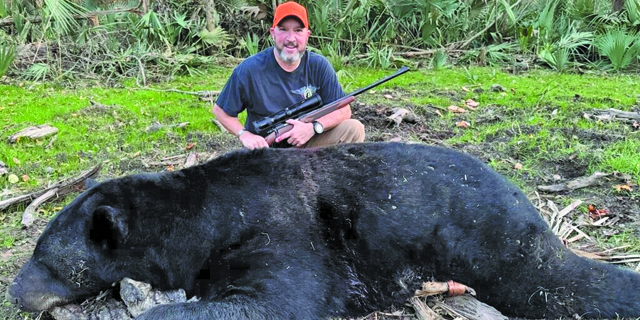This famous hole in the wall is hiding a caviar operation
Published 1:00 am Thursday, January 18, 2024

- Bon Creole
At Bon Creole Seafood in New Iberia, customers flock for the gumbo, award-winning, atomic poboys and plate lunch specials – among other favorites – many unaware that the cinder-block building covered with Cajun murals is a production site for one of the world’s most luxurious condiments: caviar. Owner Randy Montegut, who has spent a lifetime researching, selling and cooking Louisiana’s seafood, has been a leading producer of bowfin caviar, under the label Imperial Orleans, for more than 30 years.
With a master’s degree in fishery biology, the Reserve native worked as an agriculture extension agent for years before opening a crawfish and crab processing plant in Loreauville. When imported crawfish affected Louisiana’s prices, he decided to tap into his deep connections within the seafood industry and abroad to start processing caviar. As he shares, “I knew of others producing caviar. I was exporting whole crawfish to Sweden at the time, and with a contact there we started. There were no books on the subject or anyone to teach me. I went to the LSU library one day and found a National Geographic article from the ‘20s that showed pictures of processing caviar, which gave me a good idea. We started in salt water and experimented from there, opening Imperial Orleans in the late ‘80s.”
Trending
Today the company is one of only three caviar producers in the state. Fish eggs for the caviar are sourced from bowfin, a fish that dates back about 150 million years, better known locally as choupique (shoe-pick,) wild caught in the nutrient-rich Atchafalaya basin. It’s a short harvest season from mid-December until the end of January, sometimes into February, catching fish no smaller than 22” in full length that hold eggs mature enough to be processed.
“I have someone who buys the fish from the fishermen and removes the eggs for me,” says Montegut. Because the roe are easily damaged, harvesting them from the sacks, or ovaries, is a delicate process requiring skill. Using gentle pressure with the hands, they are separated from the membrane through a mesh screen. “The eggs break down quickly so in the last 15 years the fishermen have learned how to harvest them and put them on ice,” notes Montegut who retrieves them daily for processing.
His grandson, Christopher Louviere, his right-hand man, who is being groomed to eventually take over the business, has been processing the eggs for the past 10 years and knows the business as well as anyone. An industrial technology graduate, he began helping his grandfather during caviar season at 16 years old. “I always thought I’d work outside of Louisiana, but here I am and I like what I do working with my grandpa every day,” says Louviere.
The making of caviar seems simple enough, rinsing the roe with cold water and then lightly salting them the same day to preserve the fine skins. With no artificial additives, colorings or preservatives, the eggs become caviar usually within 45 minutes. Make no mistake, maturing caviar is a culinary art that Montegut has passed down.
A batch renders 20 to 30 pounds of the tiny glistening “fruits of the fish,” which Montegut samples a bit of with his fingers to ensure taste and what he calls a “dry caviar.” The delicacies are then frozen in plastic pails at a temperature below zero until they are shipped across the country from Florida to New York and New Orleans to California. Imperial Orleans caviar is sold in large quantities to customers who will repack it in tins under their label as well as to some of the finest restaurants, with 4-ounce glass jars available at Bon Creole, while supplies last. A good harvest year renders 4,000 to 5,000 pounds of caviar; Montegut recalls fondly the year he and Louviere produced 14,000 pounds.
A purist, Montegut likes his caviar on a little toast or unsalted cracker – occasionally with smoked salmon. He recommends that it be consumed within two weeks after thawing otherwise he says, “If it’s not going to be consumed the same day after thawing, I’ll tell customers to take half out – and don’t double dip the spoon in the jar – then refreeze the rest for a short time.” Among the merchandise offered by Imperial Orleans is the mother-of-pearl spoon traditionally used to serve the roe, as metalware can react with the caviar and give a strange taste.
Trending
The naturally black eggs of the bowfin are a smaller size, about 2mm, similar in size to Osetra Russian caviar, Montegut points out. The bowfin diet of crawfish, shrimp and other seafood from Louisiana’s Gulf, contributes to its caviar’s milder, delicate, some say nutty, flavor that has won over many chefs who had previously used the more expensive varieties. Proud of his product Montegut claims, “Our caviar is on the low end of the cost spectrum, but after it’s fresh caught, can compare with some of the Osetra, paddlefish and hackleback. When it’s first processed, you don’t pick up a salty or fishy taste at all.”
Just before Thanksgiving Louviere was calling the fishing docks anxious to get an update on the status of bowfin catches. “Our customers are already calling because we didn’t have much last year, and they want to make sure they get some,” he informs. However because of last summer’s drought, he and Montegut are concerned about this year’s production as well. “Some fishermen speculate that low water levels in the basin drove many of the bowfins into pools of backwater where the alligators have eaten them,” reports Montegut. “On top of that, we don’t have the number of fishermen we had before; we’ve lost the older ones, and the others can make more money fishing two sacks of crawfish instead.
“That’s why we don’t put all of our eggs in that basket. (No pun intended) Thank God we have the restaurant. I purchased the building that is Bon Creole as a location to produce caviar. Because bowfin is such a short season, I started making poboys at lunch five days a week, and then we added evenings; and five days turned to six days, and it all took off. That was 41 years ago.”




